Preferences
Language
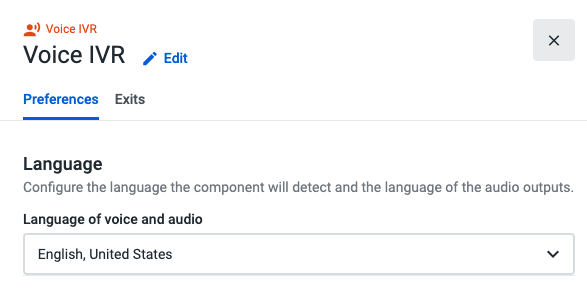
In this section, you must select the language the component will detect when the caller speaks to your IVR (it’s the language of the voice). It’s the same language you must use in the next section when you write a message for your callers (the language of the audio). You can choose from the following languages and language varieties:
- Catalan (Spain).
- Chinese (Mandarin).
- Chinese (Cantonese).
- Chinese (Taiwanese Mandarin).
- Danish (Denmark).
- Dutch (Netherlands).
- English (Australia).
- English (Canada).
- English (India).
- English (UK).
- English (United States).
- Finnish (Finland).
- French (Canada).
- French (France).
- German (Germany).
- Hebrew (Israel).*
- Italian (Italy).
- Japanese (Japan).
- Korean (South Korea).
- Norwegian Bokmål (Norway).
- Polish (Poland).
- Portuguese (Brazil).
- Portuguese (Portugal).
- Spanish (Mexico).
- Spanish (Spain).
- Swedish (Sweden).
- Russian (Russia).
NoteIf Hebrew is selected, the Text to Speech option in the “Play audio message” section will become unavailable since the language can be recognized by the component, but cannot be converted to speech to output to the user. To output a message in Hebrew, the user can select one of the other options - Audio File Upload or Other Sources - to upload or add a link to an audio file.
Play Audio Message
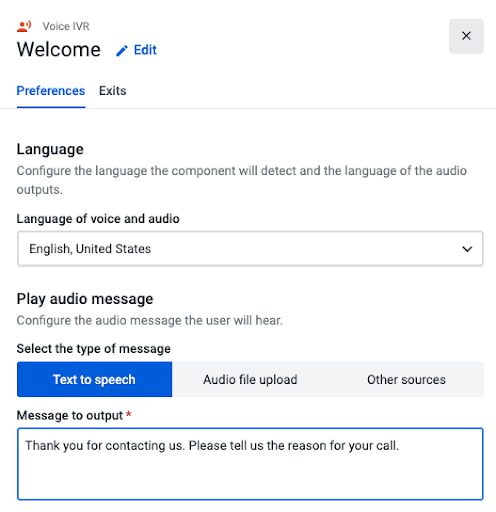
In this section, you must configure the message that the caller will hear when the flow reaches this component. The message should explain which IVR options are available and must be in the language you selected in the previous section.
You can choose one of the following message types: Text to Speech, Audio File Upload or Other Sources.
Text to speech
Type in a message that will be converted to audio and played to your customers.
NoteClick here to know more about using Text-to-Speech powered by Amazon Polly.
Audio File Upload
Upload an audio file directly from your computer. The audio file can be reused within the same or other flows in "Play Audio", "Standard IVR", "Input IVR", and "Voice IVR" components.
Before saving your flow, click on the Test audio button to make sure the file is in perfect condition.
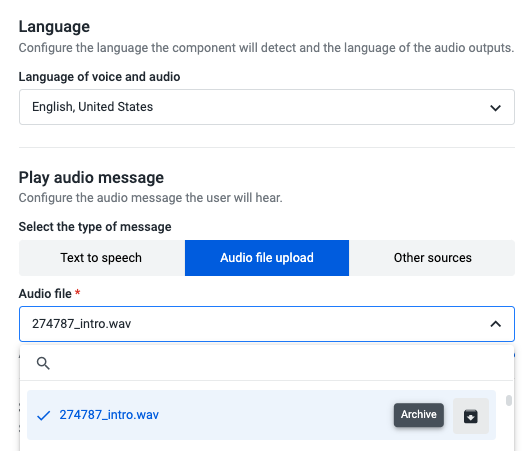
To archive audio files in use and store them away, open the “Audio file” dropdown, select the file, and click “Archive”. Please visit Archiving an Audio File to find out more about this feature.
Other Sources
Choose from entering a URL to play an audio file that must be in either MP3 or WAV format, or selecting a variable that has been previously used in your call flow, to play an audio message.
Before saving your flow, click on the Test audio button to make sure the file is in perfect condition.
NoteIf you fill out more than one message type form, only the one that is selected when you save your flow is applied.
Speech recognition
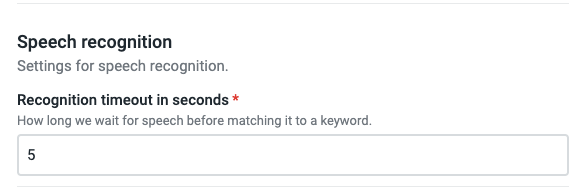
Here you must configure how many seconds without speech the system will wait before it times out and follows one of the three possible exits: "Voice Command", "No Match" or "Timeout". The speech recognition timeout has a maximum value of 120 seconds.
Variables
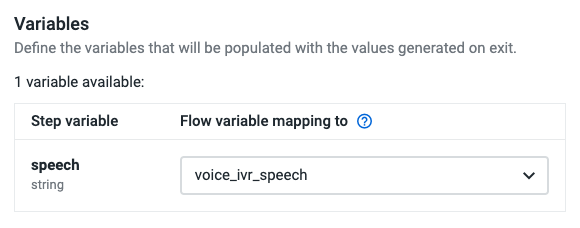
The variable you define here will store the transcribed text so you can use it further down in the flow or in Callbar.
Please click here to learn more about the supported audio files and some best practices for audio recordings.
Updated about 2 months ago